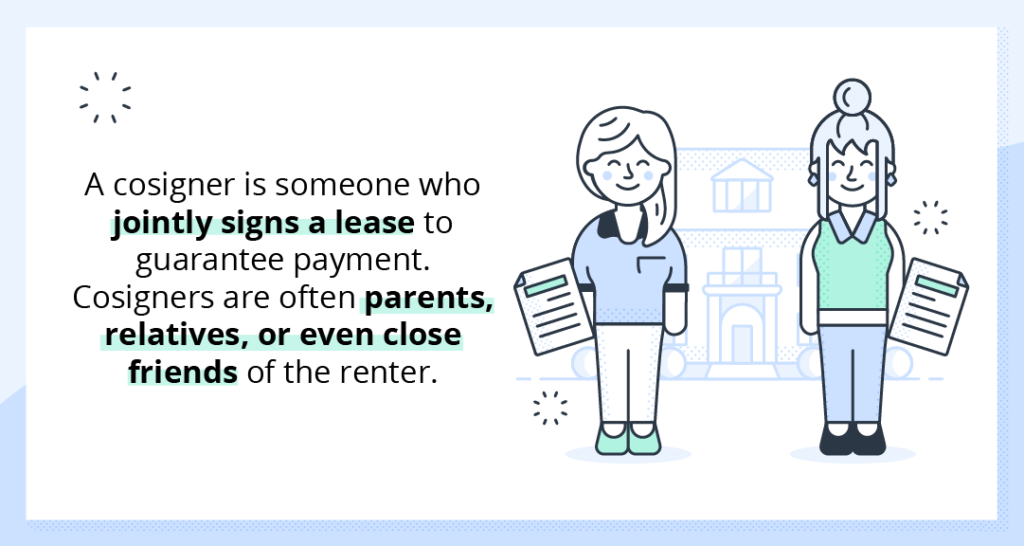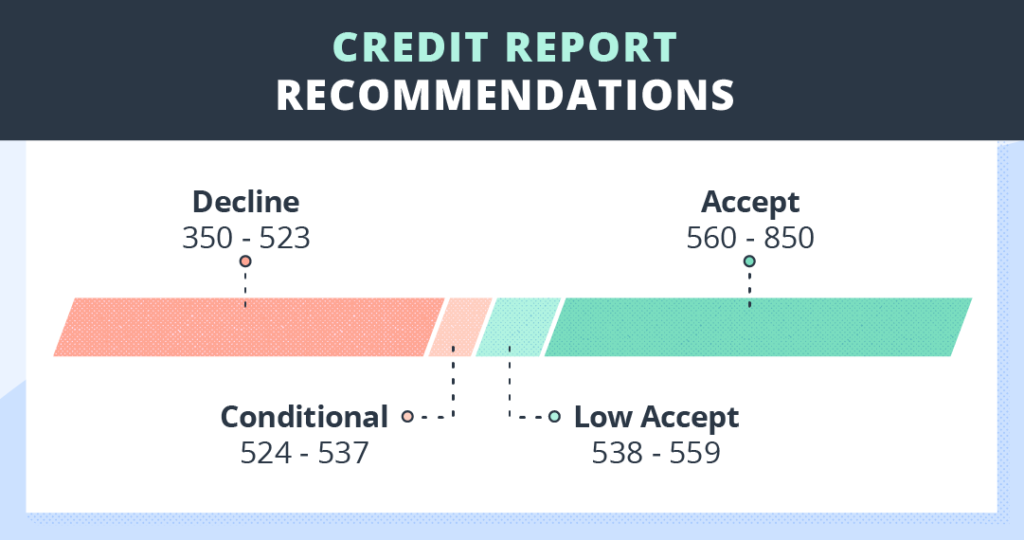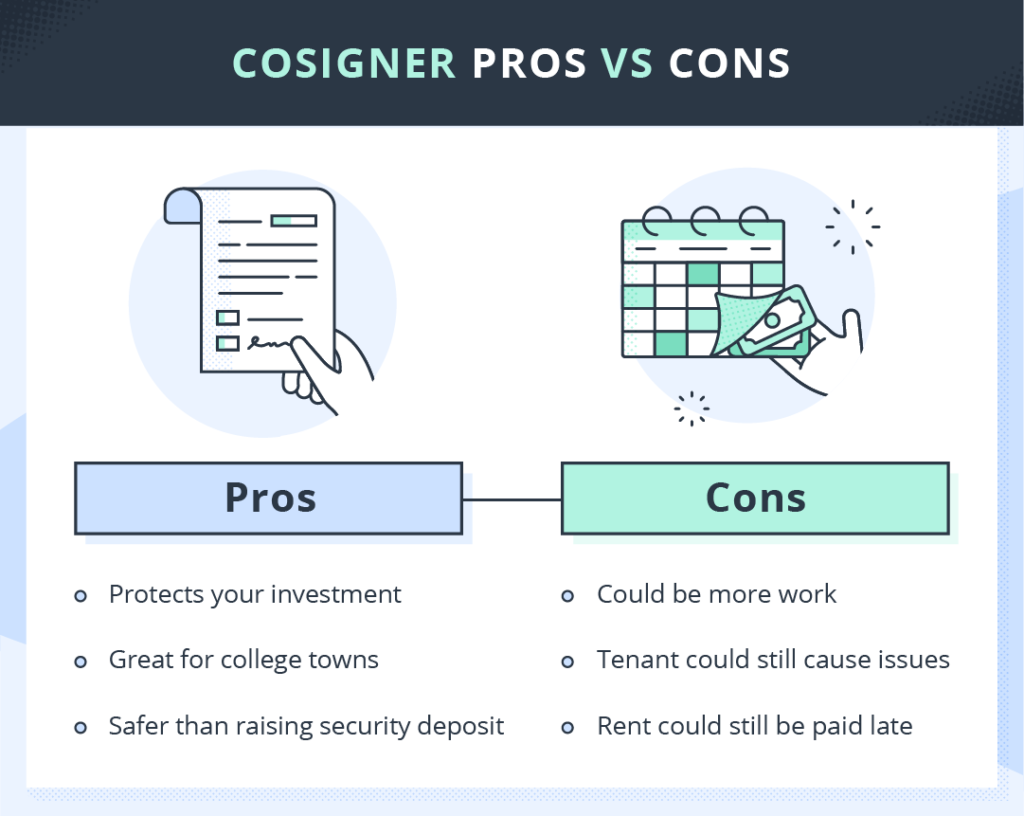Although it’s impossible to predict with certainty who will make the most reliable tenant, tenant screening gives you the best picture of someone’s background and financial history so you can confidently pick the right renter for your property. The most important indicator if a tenant can and will pay rent is an applicant’s credit score.
But what if an otherwise perfect tenant has a low credit score?
That’s when requiring a co-signer on the lease comes in. Below, we will guide you through what a lease co-signer is, the pros and cons of adding a co-signer, and how to add a co-signer to a lease.

What is a Co-Signer?

A co-signer is someone who jointly signs a loan or a lease with another person to guarantee payment. Most people are familiar with co-signers when it comes to taking out a loan – for example, if someone is young or has had financial troubles, loan companies often require co-signers. In the same way a co-signer takes financial responsibility for a loan, a co-signer on a lease is taking the financial responsibility for paying rent or other charges related to the property if the tenant fails to pay.
Because co-signers are legally accountable for ensuring the rent gets paid, landlords can feel more confident in renting to a particular tenant. Co-signers are often parents, relatives, or even close friends of a renter.
Why Tenants Might Need a Co-Signer
After you run a tenant screening report, you may discover your prospective renter has a lack of credit history or a poor credit score along with their collections, bankruptcies, and lines of credit.
Renting to tenants who have a low credit score means they could have a history of missing payments, which is usually a red flag. But sometimes renters are young, such as college students, and might not even have a credit score yet. This is often when a parent or family member would come in as a co-signer on a lease to guarantee the rent as their financial responsibility.
Because credit scores can range, landlords need to determine what their renting criteria will be; some might be okay with more risky acceptance renting criteria than others. Below are general accept-and-decline credit score guidelines to consider:
- 350-523: Decline
- 524-537: Conditional
- 538-559: Low Accept
- 560-850: Accept

Pros and Cons of Co-Signers
As you debate whether to rent to a specific renter with a co-signer or to choose a different applicant, it’s important to assess the pros of having a co-signer on a lease:
Pros
- Protects Your Rental Investment: Having a second-party guarantee the rent will be paid covers your bases with a tenant who has a low credit score.
- Great for College Towns or Young Renters: Co-signers are a great option for rental properties in college towns or places with younger renters as you will have an increased chance of filling your vacancies in these places. Oftentimes, young roommates will each need a co-signer.
- Safer Than Higher Security Deposit: While some people suggest charging a higher security deposit to safeguard your investment from renters with bad credit, sometimes this won’t make up the loss of nonpayment of rent, plus, most states have a cap on how much landlords can charge for a security deposit.
Cons
- Doesn’t Safeguard Bad Behavior: Even with a co-signer guaranteeing rent, this doesn’t mean the tenant won’t cause other issues for you whether it’s noise complaints, bad behavior, or other lease violations. For help finding a good tenant, check out our Landlord’s Guide to Screening Criteria!
- Could be More Work: There could be a situation where you are chasing down both parties to get the rent paid which can be inconvenient and cause more work for you. This is why we recommend setting up online rent payments so there is no back and forth or checks getting lost in the mail.
- Rent Could Still be Paid Late: Even with a co-signer, rent can be delayed whether it’s the tenant or the co-signer who is late to pay. This means a longer time for you to receive your rent money.
Ultimately, if you have other great applicants that wouldn’t require a co-signer, it might save time and make sense for you to rent to a different person that meets your renting criteria by themselves.

How Do I Add a Co-Signer to a Lease?
It is highly recommended that you have a co-signer lease agreement outlining the responsibility they are taking over as it’s important for you to have a written record of the relationship. Be clear about the terms so misunderstandings don’t arise later.
The process of adding a co-signer to a lease is fairly straightforward – here’s a step-by-step breakdown:
- Communicate with the renter why you will be requiring a co-signer and the role the co-signer will take. Remind them it should be someone who is financially stable enough to take responsibility, should they fail to pay rent or other fees.
- Once they have found a co-signer, treat them as an additional tenant and have them fill out an online rental application, and run a screening report to ensure they are financially fit to be a co-signer.
- Create your state-specific lease agreement outlining the terms of the co-signer and the responsibility of each party and add both parties to the lease agreement.
- Get all parties to sign so the lease agreement is legally binding. Make sure they both understand when and how rent should be paid every month. In your TurboTenant account, you can get important documents e-signed to eliminate time and make it easy for co-signers who might live in a different area.
Adding a co-signer to a lease will protect your rentals and increase the ROI of your property investment. Understanding and setting your renter acceptance criteria from the get-go will help you stick to your policies and be clear with applicants while also following Fair Housing laws. If you have recently added a cosigner to a lease, don’t forget to set up online rent payments to make it more convenient, fast, and secure for everyone.
Finding (& Respecting) a Co-Signer
Relatives like parents, good friends, or even a co-signer service are all excellent choices for a co-signer. If your applicant opts to use a relative or friend, the most common co-signers, there are a couple of things to note:
- This person must be financially stable enough to serve as a backup for rent payments
- The applicant should have good rapport with them
When it comes to needing a co-signer, there is absolutely nothing to be ashamed of. If anything, a co-signer serves as proof that someone trusts your applicant enough to vouch for their credibility and responsibility.
It’s crucial that your tenant extend the same respect to their co-signer as they do for you. They can achieve this by paying rent on time, taking care of your rental property, and maintaining open communication with both their co-signer and you as a landlord.
Co-Signer Lease Agreement FAQs
Should I screen a co-signer too?
You should always screen co-signers as they will take responsibility for missed rent payments when the renter fails to pay. Tenant screening will confirm the co-signer can afford to take the financial repercussions.
What if the tenant refuses to have a co-signer?
If a tenant refuses to have a co-signer, it could be another red flag – they might not be the best fit for your property. If you have streamlined your rental marketing online, you will hopefully receive many renter leads interested in your property that will match your rental acceptance criteria better.
Does the co-signer or the renter pay the rent?
While you will decide specific arrangements with the tenant and the co-signer, typically the co-signer will only pay the fees and rent when the renter fails to do so – they are a backup. In some other cases, like with students and parents, co-signers agree to pay the rent every month on behalf of the renter.







